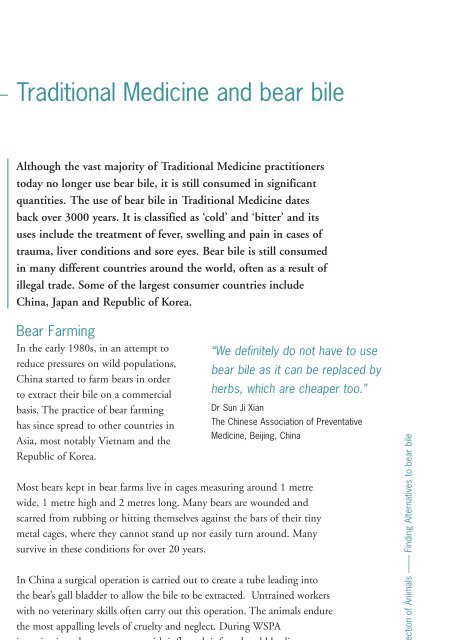Finding Herbal Alternatives to Bear Bile - WSPA
Finding Herbal Alternatives to Bear Bile - WSPA
Finding Herbal Alternatives to Bear Bile - WSPA
- No tags were found...
Create successful ePaper yourself
Turn your PDF publications into a flip-book with our unique Google optimized e-Paper software.
Traditional Medicine and bear bileAlthough the vast majority of Traditional Medicine practitioners<strong>to</strong>day no longer use bear bile, it is still consumed in significantquantities. The use of bear bile in Traditional Medicine datesback over 3000 years. It is classified as ‘cold’ and ‘bitter’ and itsuses include the treatment of fever, swelling and pain in cases oftrauma, liver conditions and sore eyes. <strong>Bear</strong> bile is still consumedin many different countries around the world, often as a result ofillegal trade. Some of the largest consumer countries includeChina, Japan and Republic of Korea.<strong>Bear</strong> FarmingIn the early 1980s, in an attempt <strong>to</strong>reduce pressures on wild populations,China started <strong>to</strong> farm bears in order<strong>to</strong> extract their bile on a commercialbasis. The practice of bear farminghas since spread <strong>to</strong> other countries inAsia, most notably Vietnam and theRepublic of Korea.“We definitely do not have <strong>to</strong> usebear bile as it can be replaced byherbs, which are cheaper <strong>to</strong>o.”Dr Sun Ji XianThe Chinese Association of PreventativeMedicine, Beijing, ChinaMost bears kept in bear farms live in cages measuring around 1 metrewide, 1 metre high and 2 metres long. Many bears are wounded andscarred from rubbing or hitting themselves against the bars of their tinymetal cages, where they cannot stand up nor easily turn around. Manysurvive in these conditions for over 20 years.In China a surgical operation is carried out <strong>to</strong> create a tube leading in<strong>to</strong>the bear’s gall bladder <strong>to</strong> allow the bile <strong>to</strong> be extracted. Untrained workerswith no veterinary skills often carry out this operation. The animals endurethe most appalling levels of cruelty and neglect. During <strong>WSPA</strong>investigations, bears were seen with inflamed, infected and bleedingwounds, open incisions for bile extraction and swellings in the abdominalarea. In some farms sick bears lay recumbent without movement. InVietnam bile is extracted using ultrasound equipment and a hypodermicsyringe, bile is extracted approximately once a month. In Korea, bears donot have bile extracted from them when they are alive. Instead, the bearsare raised <strong>to</strong> a certain age and are then slaughtered for their body parts.World Society for the Protection of Animals —— <strong>Finding</strong> <strong>Alternatives</strong> <strong>to</strong> bear bile5
















